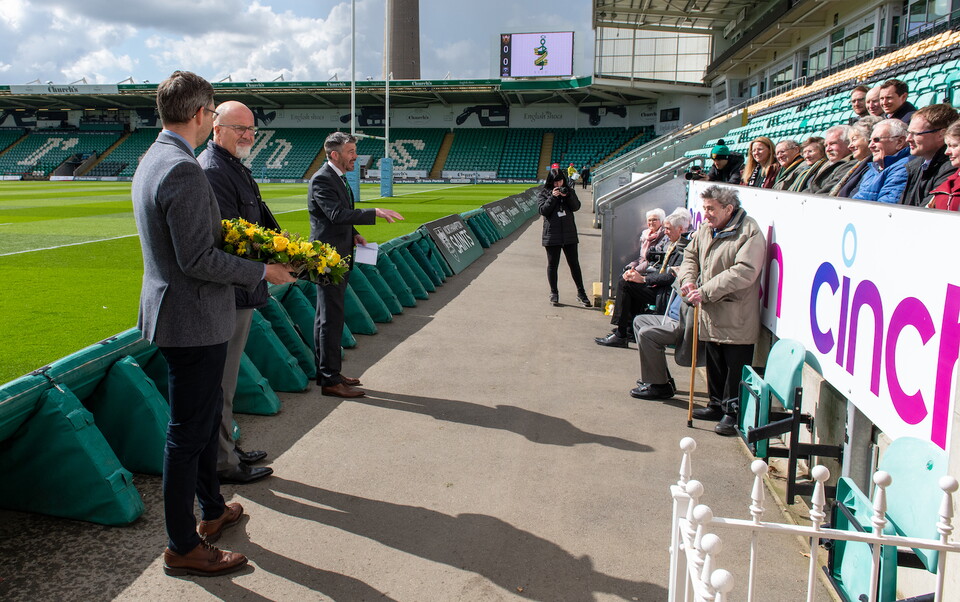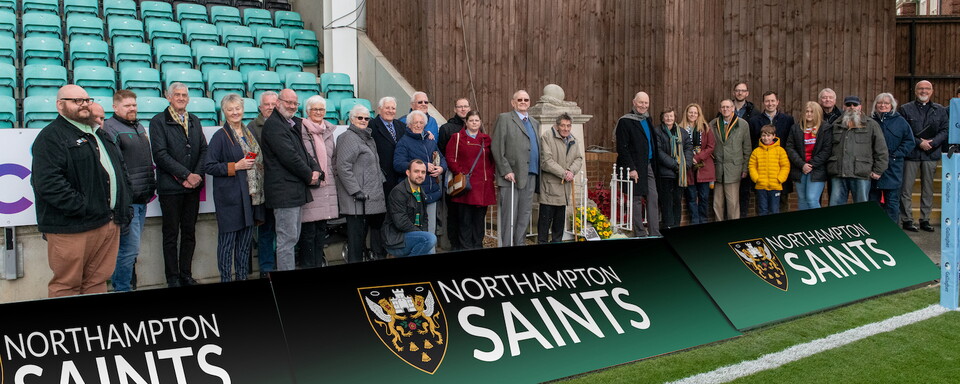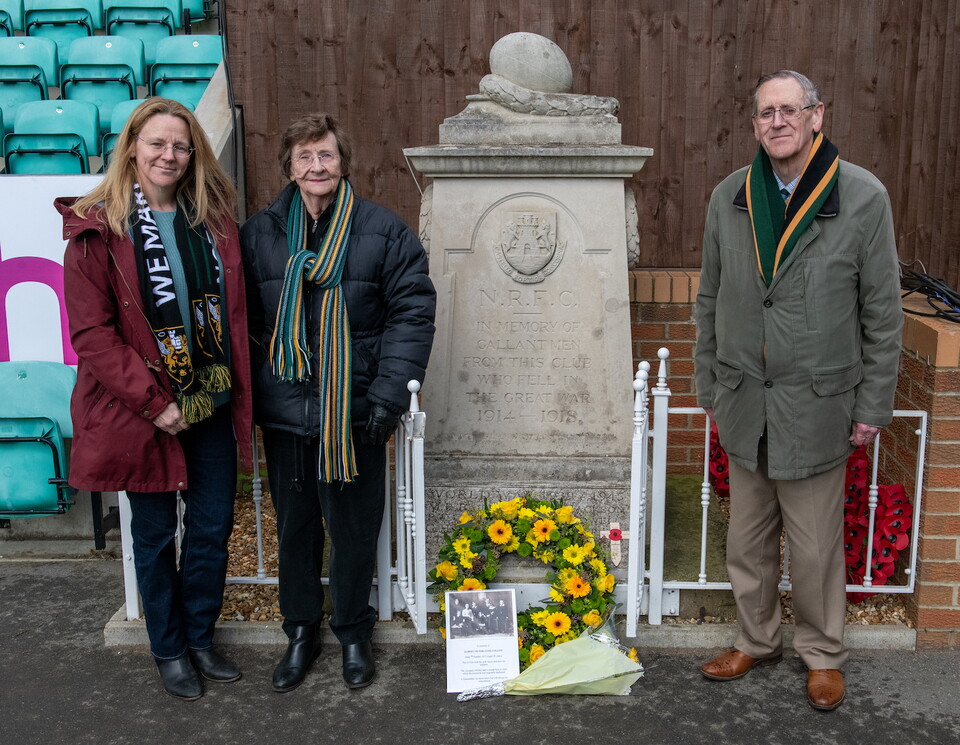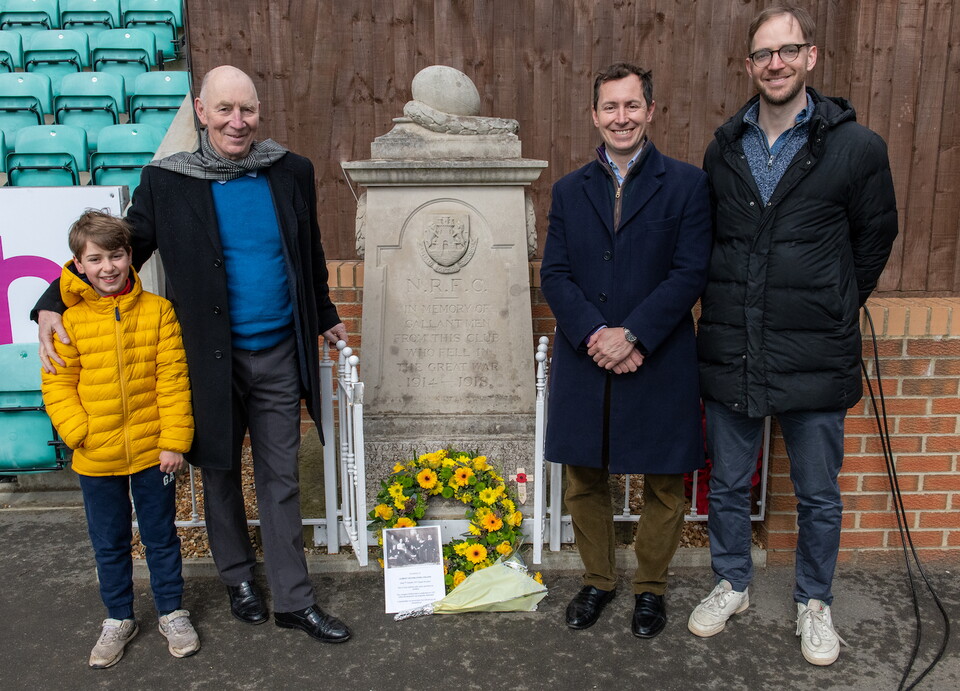Northampton Saints’ Historian Graham McKechnie reflects on a small but significant gathering around the Club’s War Memorial on Saturday afternoon…
Before Saints’ Premiership match against Bristol Bears, the Club commemorated the 100-year anniversary of the unveiling of the War Memorial which now stands in the north-east corner of the ground.
Our chaplain, Jez Safford, and I welcomed the descendants of Tom Collins, Archie Field, and Blair Swannell – whose families were at the original unveiling of the Memorial on 1 April 1922. They came to remember these three great men, while the family of Edgar Mobbs were also present to pay their respects. Chris Boyd (Director of Rugby) and Mark Darbon (Chief Executive) represented the Club, with the latter laying a new wreath of flowers on the Memorial as part of the short service.
Around 30 people stood together in the sleet and wind to recall the events of 100 years ago, when this piece of Portland stone was originally unveiled. Many of these people had never met before, but all were bound together by two things; Northampton Saints, and the sacrifice of the men whose names are carved on that memorial.
I am invited sometimes to talk to schools about the First World War, and one of the central points is always the importance of remembrance. Why is it still important to acknowledge something that happened so very long ago? For schoolchildren today, both World Wars are of course distant events. So, to help them relate, I always come back to the families – for example, the Collins family, who were there on Saturday. It does not feel like that long ago for them, the wound is still quite raw.
Tom Collins was a stalwart of Saints. He was killed carrying a stretcher in October 1917 not far from Passchendaele, leaving a wife and six children behind. They in turn had children and many of them were at Franklin’s Gardens last Saturday to remember the grandfather they never knew. But they felt Tom’s absence as they grew up, seeing it in the grief of their grandmother Annie – clearly a formidable woman. They have said to me before that they look at the closeness of the extended family today, and wonder if it’s a legacy of the trauma the family went through in 1917 and of Annie Collins’ extraordinary strength of character.
When the War Memorial was unveiled on 1 April 1922, Annie and her youngest son, Willie, laid a wreath in remembrance of Tom. Archie Field’s widow Sarah was there too, as was his great-great-nephew one hundred years later. Archie played for Saints in the 1890s – he flirted with Leicester for a season or two, but came back to the Gardens and all was forgiven. Then, in 1898, he crossed the divide and became a professional, joining Rochdale Hornets, meaning he could never set foot inside Franklin’s Gardens again. He was killed in the Battle of Arras in 1917, wounded going over the top and then dying two days later on 30 April. Archie may have been persona non grata at the ground after he turned professional, but his wife was rightly welcomed back to lay a wreath.
Above: The War Memorial has stood at Franklin’s Gardens since 1922
The legendary Saints forward Blair Swannell’s mother came back to the Gardens in 1922, along with his brother and sister. Blair was Saints’ first-ever international, playing for the Lions in 1899 in Australia. Truly one of the Club’s greatest characters, his face adorns the side of the Carlsberg Stand today alongside other legends who have worn the Black, Green and Gold. Swannell emigrated to Australia in 1904 – playing for the Wallabies in New Zealand the following season – before returning with the Australian Infantry and meeting his end on the slopes of Gallipoli in 1915. Three generations of Swannells came back to the Gardens last Saturday, including his great-great-great-nephew, Ally.
Dick Spanton’s sister was also present in 1922 – the other family member to lay a wreath. He played for Saints in the final season before the War. He was a machine-gunner for the 5th Battalion, Northamptonshire Regiment, and was killed in March 1918. I haven’t yet been able to trace the Spanton family, but perhaps if you’re reading this and can help, you could let me know.
While the Mobbs family also attended on Saturday afternoon, messages had been sent from others, from as far afield as William West’s granddaughter in Canada.
It was a very moving experience, seeing these families together – remembering men they never knew but who have made such a lasting impression on them, on the Club, and on the wider society. As the sleet fell and we repeated Laurence Binyon’s words, “We will remember them”, I wondered how much longer can we keep that promise?
But it was reassuring to see so many young members of the families there, to carry on the tradition, and to hear Chris Boyd say that it was something he discussed with his Saints players before the match against Bristol that afternoon. There is every reason to hope that given the prominence of the War Memorial at Franklin’s Gardens, and the Club’s understanding of the importance of its history, for the foreseeable future there is no danger that the sacrifice these men made for us will ever be forgotten.
Above: The Collins, Field, Swannell and Mobbs families paid their respects








